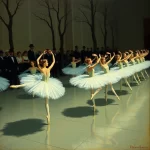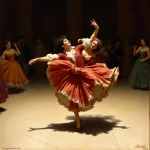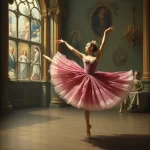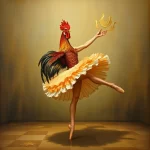Ballet: Parade (Erik Satie, 1917)

Introduction
Ballet: Parade, composed by Erik Satie in 1917, is a one-act ballet that stands as a significant work in the history of modern dance and music. The ballet was choreographed by Léonide Massine, with a libretto by Jean Cocteau and set and costume designs by Pablo Picasso. It premiered on May 18, 1917, at the Théâtre du Châtelet in Paris. The ballet’s plot revolves around a group of circus performers attempting to attract an audience to their show, blending elements of surrealism and modernism.
Historical Background
Creation and Development
The creation of Parade occurred during a period of significant upheaval and transformation in Europe, marked by World War I and the burgeoning modernist movement in the arts. The ballet was conceived as a collaborative effort among some of the most innovative artists of the time. Jean Cocteau, inspired by the avant-garde spirit, sought to create a work that broke away from traditional ballet conventions. He enlisted the help of Erik Satie, known for his unconventional compositions, and Pablo Picasso, whose cubist designs added a unique visual element to the production.
The inspiration behind Parade came from various sources, including popular entertainment forms like circuses and music halls. Cocteau’s libretto aimed to capture the essence of these performances while infusing them with a modernist twist. The collaboration between Cocteau, Satie, Massine, and Picasso resulted in a groundbreaking work that challenged the boundaries of ballet and integrated multiple art forms.
Premiere and Reception
Parade premiered on May 18, 1917, at the Théâtre du Châtelet in Paris. The initial reception was mixed, with some critics and audience members finding the ballet’s avant-garde elements perplexing and controversial. However, others praised its innovative approach and the seamless integration of music, dance, and visual art. Notable early performances included revivals in the 1920s and 1930s, which helped solidify Parade’s place in the ballet repertoire.
Synopsis of the Ballet
Parade is a one-act ballet that unfolds in a single continuous scene. The plot centers around a group of circus performers who stage a parade to attract an audience to their show. The performers include a Chinese Conjuror, an American Girl, and two Acrobats. Despite their best efforts, the parade fails to draw a crowd, leading to a series of humorous and surreal events.
Key Moments
- Opening Scene: The performers prepare for the parade, showcasing their unique talents and costumes.
- Chinese Conjuror’s Act: The Conjuror performs a series of magic tricks, blending traditional Chinese elements with modernist flair.
- American Girl’s Dance: The American Girl performs a lively dance, incorporating elements of jazz and popular dance styles of the time.
- Acrobats’ Performance: The Acrobats execute a series of impressive stunts, highlighting their physical prowess and coordination.
- Conclusion: Despite their efforts, the performers fail to attract an audience, leading to a humorous and somewhat melancholic ending.
Musical Composition
Composer’s Role
Erik Satie, a pioneering composer known for his minimalist and avant-garde style, played a crucial role in the creation of Parade. His score for the ballet is characterized by its use of unconventional instruments, including typewriters, sirens, and airplane propellers, which added a unique auditory dimension to the performance. Notable pieces within the score include the “Ragtime du Paquebot” and the “Petite Fille Américaine,” which reflect Satie’s ability to blend different musical genres and styles.
Musical Themes and Motifs
The music of Parade features recurring themes and motifs that enhance the narrative and emotional impact of the ballet. Satie’s use of leitmotifs helps to establish the characters and their actions, while the incorporation of everyday sounds creates a sense of realism and modernity. The music’s playful and whimsical nature complements the ballet’s surreal and humorous elements, making it an integral part of the overall experience.
Famous Recordings and Performances
Several iconic recordings of Parade’s music have been made over the years, showcasing the enduring appeal of Satie’s score. Notable performances include those by the Orchestre National de France, conducted by Manuel Rosenthal, and the London Sinfonietta, conducted by David Atherton. These recordings capture the essence of Satie’s composition and continue to be celebrated by music enthusiasts and ballet aficionados alike.
Choreography and Dance
Choreographer’s Vision
Léonide Massine, the choreographer of Parade, brought his unique vision and style to the ballet. Massine’s choreography was characterized by its dynamic and expressive movements, which reflected the modernist themes of the work. He sought to break away from traditional ballet techniques, incorporating elements of popular dance and physical theater to create a more accessible and engaging performance.
Signature Dance Numbers
- Chinese Conjuror’s Act: This dance number features intricate and fluid movements, blending traditional Chinese dance with modernist elements.
- American Girl’s Dance: A lively and energetic performance that incorporates jazz and popular dance styles, reflecting the character’s vivacious personality.
- Acrobats’ Performance: A physically demanding and visually impressive routine that showcases the acrobats’ strength and coordination.
Notable Interpretations
Over the years, various productions of Parade have interpreted and adapted Massine’s choreography in different ways. Some have emphasized the ballet’s surreal and humorous aspects, while others have focused on its modernist and avant-garde elements. Notable interpretations include those by the Ballets Russes, the Paris Opera Ballet, and contemporary dance companies, each bringing their unique perspective to the work.
Characters and Roles
Main Characters
- Chinese Conjuror: A magician who performs a series of magic tricks, blending traditional Chinese elements with modernist flair.
- American Girl: A lively and energetic dancer who incorporates jazz and popular dance styles into her performance.
- Acrobats: Two performers who execute a series of impressive stunts, highlighting their physical prowess and coordination.
Supporting Characters
While the main focus of Parade is on the three primary performers, there are also several supporting characters who contribute to the overall narrative. These include stagehands, musicians, and other circus performers who add depth and context to the story.
Famous Dancers
Over the years, many notable dancers have portrayed the roles in Parade. Some of the most famous include Léonide Massine himself, who originated the role of the Chinese Conjuror, and Tamara Karsavina, who was renowned for her portrayal of the American Girl. These dancers brought their unique talents and interpretations to the ballet, helping to shape its legacy.
Cultural and Artistic Impact
Influence on Ballet and Dance
Parade has had a significant influence on the development of ballet and dance. Its innovative approach to choreography, music, and visual design challenged traditional conventions and paved the way for future modernist works. The ballet’s integration of multiple art forms also inspired other choreographers and composers to explore new creative possibilities.
Cultural Significance
Beyond its impact on ballet, Parade holds a notable place in popular culture and the broader artistic landscape. The ballet’s collaboration between Cocteau, Satie, Massine, and Picasso is often cited as a prime example of interdisciplinary artistic collaboration. Additionally, Parade has been referenced in literature, film, and other media, highlighting its enduring cultural significance.
Legacy and Revivals
Parade continues to be performed and celebrated today, with numerous revivals and reinterpretations over the years. Major revivals include those by the Paris Opera Ballet and the Joffrey Ballet, each bringing a fresh perspective to the work. Contemporary adaptations have also explored new ways to present Parade, incorporating modern technology and innovative staging techniques.
Iconic Productions
Historic Productions
Some of the most famous historical productions of Parade include its original 1917 premiere by the Ballets Russes and subsequent revivals in the 1920s and 1930s. Key figures involved in these productions included Sergei Diaghilev, the founder of the Ballets Russes, and renowned dancers like Léonide Massine and Tamara Karsavina.
Contemporary Productions
Recent productions of Parade have continued to explore new interpretations and staging techniques. Contemporary dance companies have brought their unique perspectives to the ballet, incorporating modern technology and innovative choreography. These productions often emphasize the ballet’s timeless themes and its relevance to contemporary audiences.
Production Design
The set, costume, and lighting design of Parade have played a crucial role in its overall impact. Pablo Picasso’s cubist designs for the original production were groundbreaking, adding a unique visual dimension to the ballet. Subsequent productions have built on Picasso’s work, incorporating new design elements while staying true to the original vision. Lighting design has also evolved, with modern productions using advanced technology to enhance the visual experience.
Critical Reception and Reviews
Initial Critical Response
The initial critical response to Parade was mixed, with some critics praising its innovation and others finding it perplexing. The ballet’s avant-garde elements, including Satie’s unconventional score and Picasso’s cubist designs, were both celebrated and criticized. Despite the controversy, Parade quickly gained recognition as a groundbreaking work in the world of ballet.
Modern Reviews
Contemporary critics and audiences continue to appreciate Parade for its innovative approach and interdisciplinary collaboration. Modern reviews often highlight the ballet’s historical significance and its influence on subsequent works. The enduring appeal of Parade is evident in its continued performances and revivals, which attract both new audiences and long-time fans.
Fun Facts and Trivia
Behind-the-Scenes Stories
One interesting anecdote from the production of Parade involves Erik Satie’s use of unconventional instruments in the score. Satie famously included typewriters, sirens, and airplane propellers, which added a unique auditory dimension to the ballet. This decision was initially met with skepticism but ultimately contributed to the ballet’s distinctive sound.
Notable Performers
Over the years, many famous dancers, conductors, and directors have been associated with Parade. Notable performers include Léonide Massine, who originated the role of the Chinese Conjuror, and Tamara Karsavina, known for her portrayal of the American Girl. Renowned conductors like Manuel Rosenthal and David Atherton have also contributed to iconic recordings of the ballet’s music.
Trivia
- Parade was one of the first ballets to incorporate elements of popular entertainment forms like circuses and music halls.
- The collaboration between Cocteau, Satie, Massine, and Picasso is often cited as a prime example of interdisciplinary artistic collaboration.
- Erik Satie’s use of unconventional instruments in the score was initially met with skepticism but ultimately contributed to the ballet’s distinctive sound.
Conclusion
Summary of the Ballet’s Importance
Parade is a significant work in the world of ballet, known for its innovative approach and interdisciplinary collaboration. The ballet’s integration of music, dance, and visual art challenged traditional conventions and paved the way for future modernist works. Its influence on subsequent choreographers, composers, and artists is undeniable, making it a landmark in the history of dance.
Final Thoughts
Parade remains a timeless and relevant work, celebrated for its creativity and innovation. Its enduring appeal is evident in its continued performances and revivals, which attract both new audiences and long-time fans. For those interested in experiencing this groundbreaking ballet, watching a performance or listening to the score is highly recommended.
FAQ
What is the central theme of this ballet?
The central theme of Parade revolves around a group of circus performers attempting to attract an audience to their show, blending elements of surrealism and modernism.
Who are the main characters in this ballet?
The main characters in Parade include the Chinese Conjuror, the American Girl, and two Acrobats.
What is the most famous dance number in this ballet?
One of the most famous dance numbers in Parade is the American Girl’s Dance, which incorporates jazz and popular dance styles.
How long does a typical performance of this ballet last?
A typical performance of Parade lasts approximately 20-30 minutes, as it is a one-act ballet.
Are there any modern adaptations of this ballet?
Yes, there have been numerous modern adaptations of Parade, with contemporary dance companies bringing their unique perspectives to the ballet.
Why is this ballet considered important in the history of dance?
Parade is considered important in the history of dance due to its innovative approach, interdisciplinary collaboration, and influence on subsequent works. It challenged traditional ballet conventions and paved the way for future modernist works.





